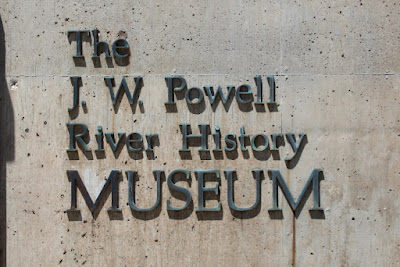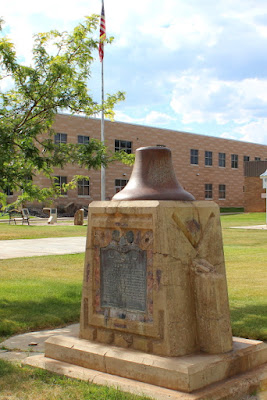On May 24, 1869, John Wesley Powell, an American geologist, with four boats and ten men departed on a three-month river trip down through the Grand Canyon. The trip actually started just north of the Utah border on the Green River as it passed through the City of Green River, Wyoming, After passing through Flaming Gorge, the Green River runs through the City of Green River, Utah, and then combines with the Colorado River southwest of Moab (Utah).
When we drove through Green River, Utah, we stopped at The J.W. Powell River History Museum that is located adjacent to the River. The museum contained several statues depicting Powell's 1869 trip, a replica of Powell's boat, and several other actual boats that were used in later years to float through the Grand Canyon. There was also a dinosaur display and a section of the museum contained historical information on the fur traders that trapped beaver in the area in the early 1800s.
As a special bonus, the World's Largest Watermelon Slice was located on a trailer in the museum's parking lot.
 |
| Picture by Kolohe |
 |
| Picture by Kolohe |
 |
| Picture by Kolohe |
 |
| Picture by Kolohe |
 |
| Picture by Kolohe |
 |
| Picture by Kolohe |
 |
| Picture by Kolohe |
 |
| Picture by Kolohe |
Located on a hill overlooking the City of Green River (Utah) are two land art sculptures by Andrew Rogers, a world renowned Australian artist. As part of his Rhythms of Life program, Rogers has constructed land art projects on all seven continents in 54 different countries.
Ratio is 44 feet tall, 42 feet long, 6-feet wide, and the 53 concrete blocks are arranged in a mathematical Fibonacci Sequence. (In a Fibonacci Sequence, the next number in the sequence is the sum of the previous two numbers; e.g. 0, 1, 1, 2, 3, 5, 8, 13, 21, ... In nature, the Fibonacci sequence is found in tree branching, arrangement of leaves on a stem, fruit sprouts of a pineapple, flowering of an artichoke, and many more.)
The Fibonacci Sequence is also related to the "Golden Ratio." According to Wikipedia, "In mathematics, two quantities are in the golden ratio if their ratio is the same as the ratio of their sum to the larger of the two quantities." Graphically, the Fibonacci Spiral is made by drawing circular arcs connecting the opposite corners of squares in the Fibonacci Sequence. This pattern is very pleasing to the human eye, so the technique is frequently used by professional artists, photographers and architects.
,

 |
| Picture by Kolohe |
A short distance from Ratio, Rogers created Elements. The four 32-feet tall columns (one topped in 23-carat gold) represent the four elements - Earth, Fire, Water and Wind. Two of the columns are each about 2-foot square and two of the columns are circular with diameters of about 2-feet. The columns are spaced approximately 2 feet apart.
Woodside (Utah) is a ghost town on the west bank of the Price River. The town received its name from the large number of Cottonwood Trees growing in the area when homesteaders arrived.
Homesteaders first arrived in 1881 and built a school, stores, hotel, café, saloon, blacksmith shop, stockyards, and canals to irrigate their crops. However, the residents soon discovered many problems with the area. Water levels in the Price River varied greatly with the seasons and the large drainage area surrounding the town caused flash floods during heavy rain storms. The population peaked in 1910 and then started a steady decline.
After WW II the town became a tourist attraction because a water well dug in the 1800s turned into a cold bubbling mudpot that was caused by naturally occurring pressurized carbon dioxide gas. The mudpot became a cold water geyser that shot mud 75-feet into the air. A new filling station, store, and café were built at the site to accommodate tourist; however, over time the geyser lost its pressure and the tourist quit stopping at Woodside. The filling station ruins are still standing and were used in the movie Thelma & Louise.
While searching for oil south of town, Utah Oil & Refining discovered a large reservoir of helium-rich gas, so the Federal Government set aside the area as "United States Helium Reserve #1." The field has never produced any helium but the potential reserves are said to be "substantial." The Government is currently just holding the helium in reserve.
 |
| Picture by Kolohe |
Out in the middle of nowhere at the junction of an unnumbered cut-across road (Emma Park Road) from U.S. Highway 6 to U.S. Highway 191 there is a large unmaintained marker standing about 100 feet from the road. A plaque on the monument stated:
Erected in 1918, by inmates of the Utah State Penitentiary. This monument honors Simon Bamberger, Governor of Utah from 1917 through 1920. Under a State Law passed in 1911 permitting prisoners to work on State Roads, the prisoners participated in road work on the Castle Gate-Duchesne Road during the summers of 1917 and 1918. The stone was obtained from the Kyune Stone Quarries in the hills northwest of the monument.
In Duchesne the first bell purchased by the community is located on a monument in front of the high school. A plaque states: "This bell was used for school, church, curfew and as a fire alarm for many years."
Just down the street in a park along the Duchesne River there are several other monuments.
One monument describes Father Escalante's 1776 journey into the area and states that his diary called the canyon just northwest of town "Canyon of the Swallows." This canyon became an important landmark for early explorers, trappers, and pioneers. Distances were often reported in days from the Canyon.
Another monument commemorates the live of Saint Rose Philippine Duchesne, who the town is named for.
Mother Duchesne came to America in 1818 and started a school in Missouri. In later years she moved west and worked with the Potowatomi Indian people and became known among the Indian Nations as "The Woman Who Always Prayed." Pope John Paul II canonized her a Saint on July 3, 1988.
The veterans memorial is quite elaborate for a small town with a population of about 1700 residents. Engraved on stone walls are the names of County veterans dating back to the Civil War.
 |
| Picture by Kolohe |
Fort Duchesne is located about 35 miles east of the City of Duchesne and is completely surrounded by the Uintah and Ouray Reservation. The Fort closed in 1912 and is now the headquarters for the Ute Indian Tribe.
Along the highway outside of town there is a beautiful memorial that is "Dedicated to the Families and Veterans who served honorably in service of their country and people." Five stone towers hold up a cauldron that is lit whenever a tribal member is killed in action.
 |
| Picture by Kolohe |


































No comments:
Post a Comment